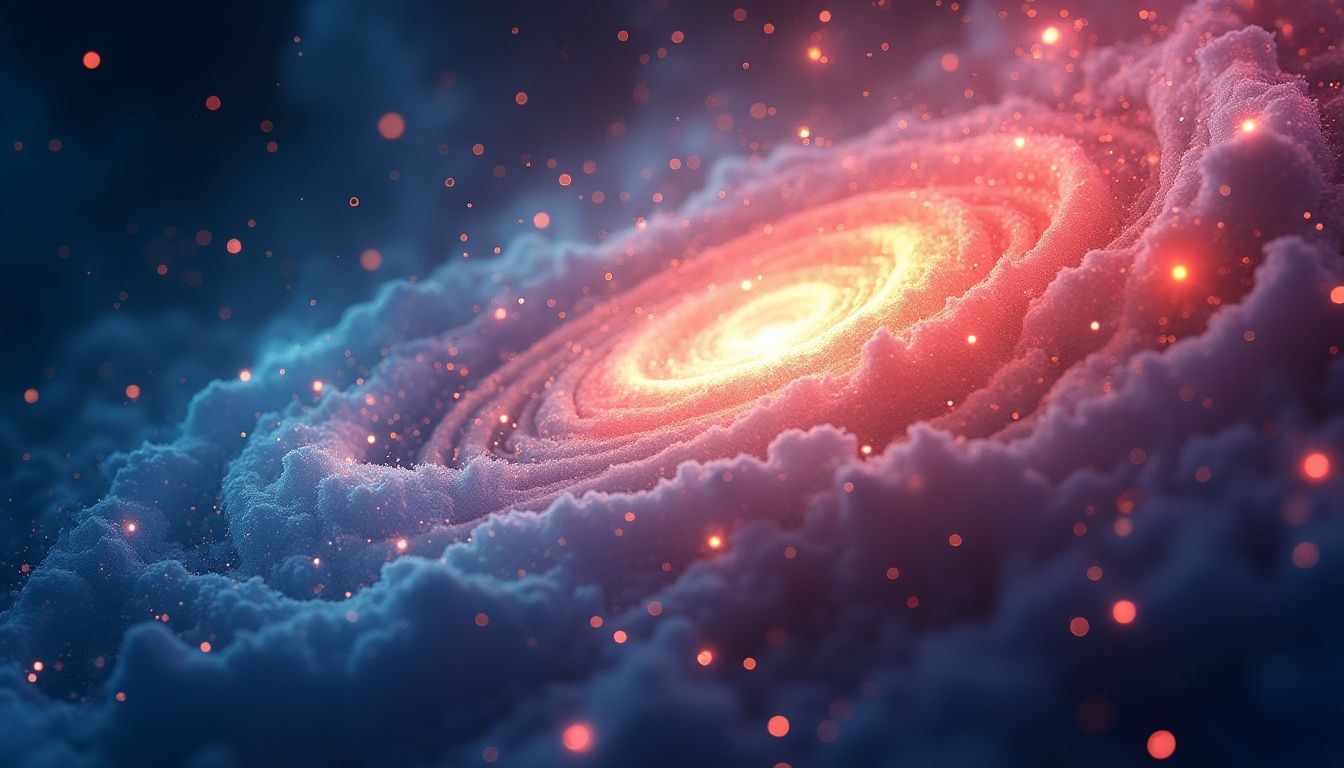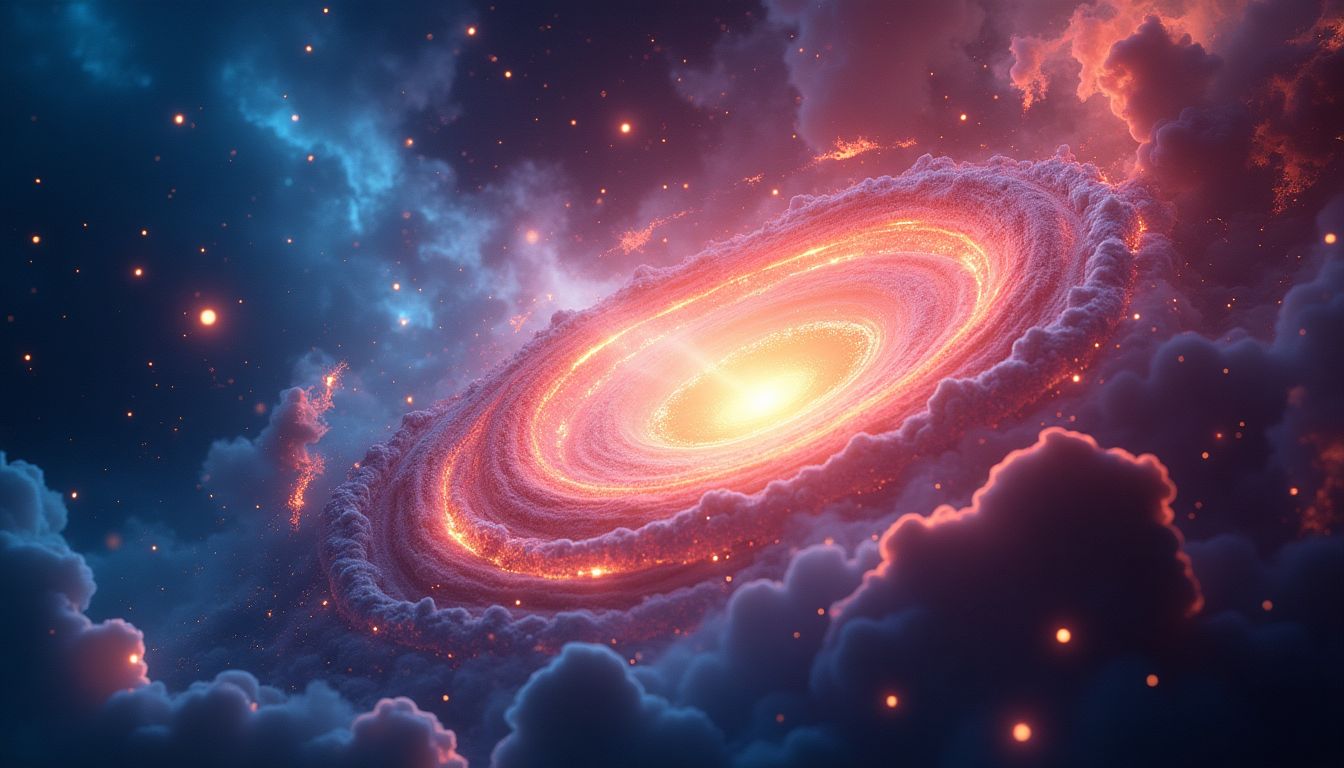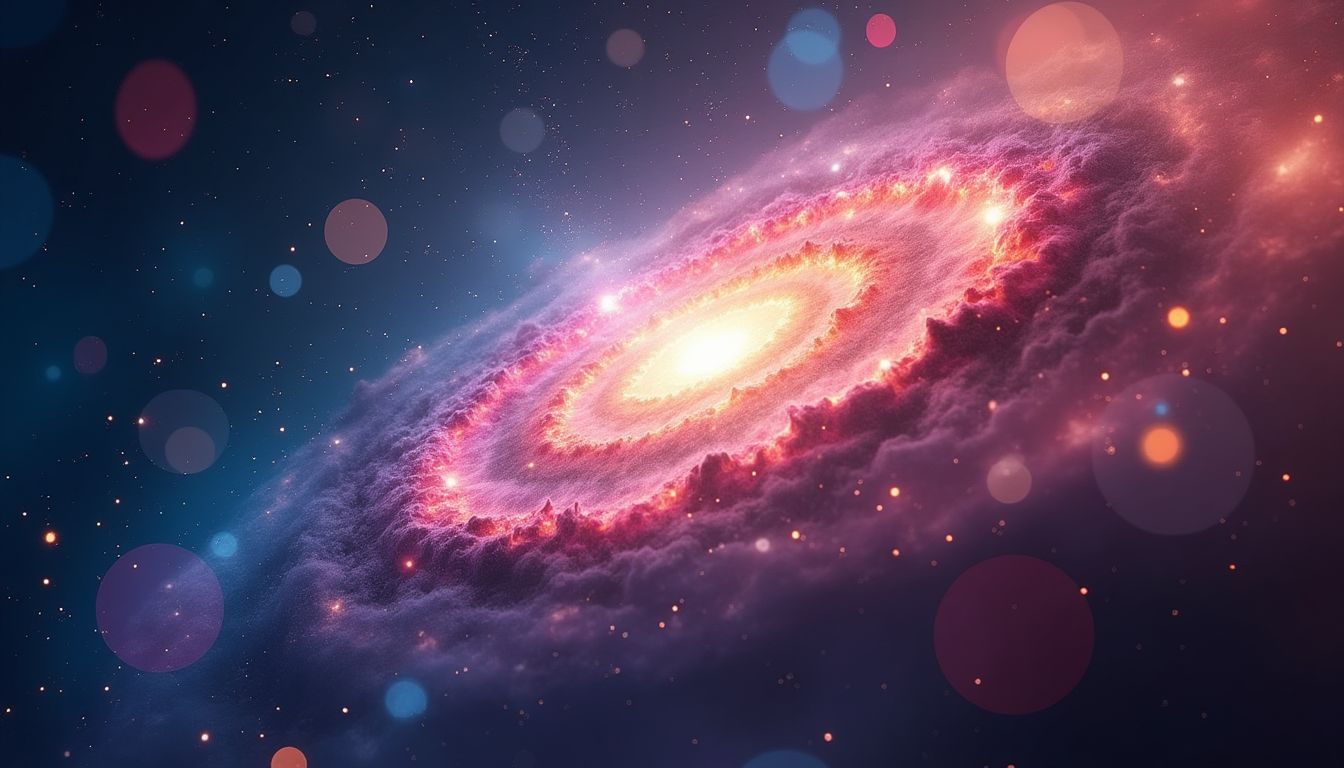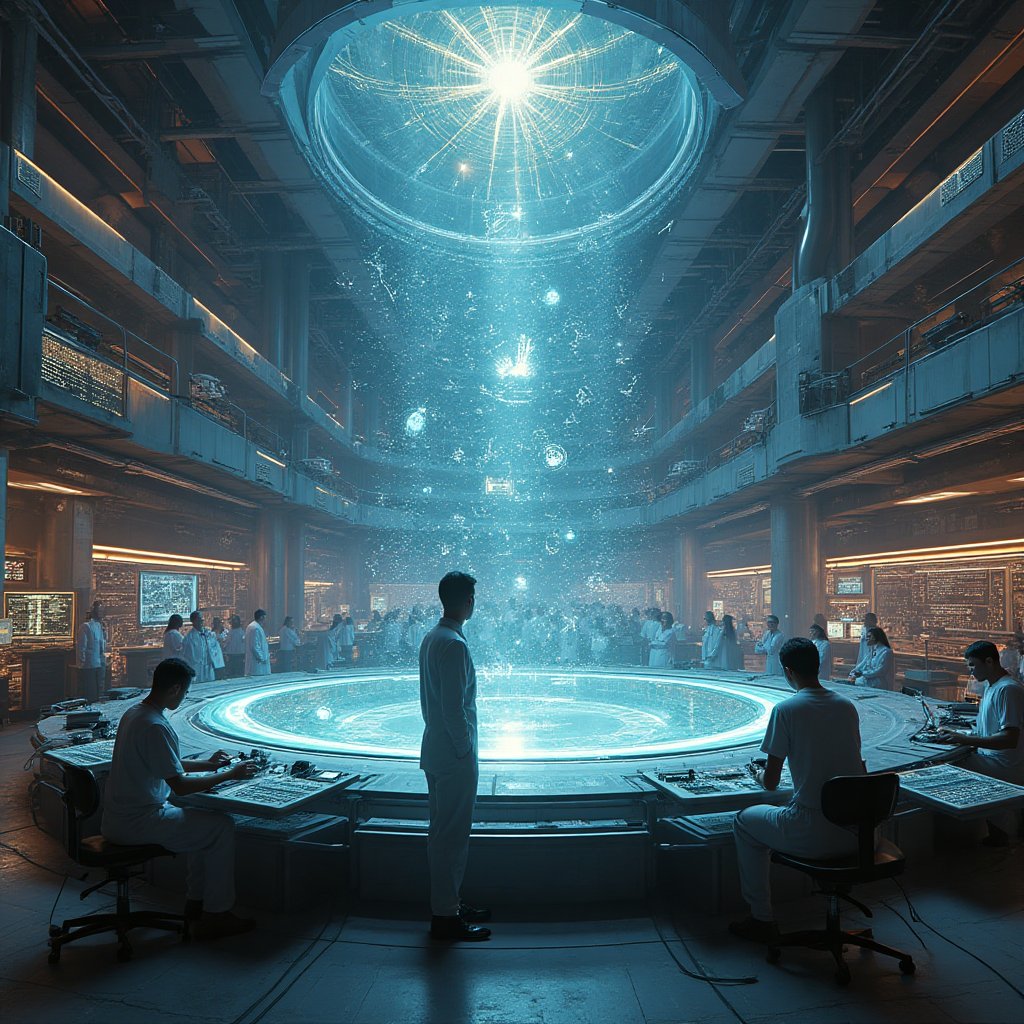Somewhere in the void of the cosmos, unseen arms cradle galaxies, holding their stars in unyielding orbit. These ghostly hands of the universe exert gravitational forces that defy all logic, yet they remain invisible to everything we know about physics. This elusive fabric, known as dark matter, and its equally puzzling sibling, dark energy, don’t just challenge our understanding of the universe—they break it altogether. Together, these enigmas account for a staggering 95% of the universe's composition. And here we stand, curtains drawn on most of existence, armed with curiosity, humility, and now—artificial intelligence.
In the words of cosmologist and Nobel laureate Saul Perlmutter, the discovery of dark energy “was like being smacked upside the head by the universe.” Yet, decades after his Nobel-winning research, we know little more than what jolted that revelation into existence. From the musings of astrophysicist Neil deGrasse Tyson to the meticulous studies by particle physicists like Vera Rubin and Fritz Zwicky, dark matter and dark energy remain as mysterious as ever. But what if I told you this might all change? What if AI holds the key to decoding these mysteries in a way human minds alone never could?
In labs, observatories, and think tanks across the globe, researchers are harnessing the computational prowess of cutting-edge AI. From simulating billions of alternate universes to spotting anomalies in sprawling datasets, these algorithms are breaking barriers that once seemed insurmountable. But it’s not just about data; it’s about revolution. This is the beginning of a cosmic reckoning, a paradigm shift that could shed light on fundamental physics, redefine humanity’s place in the universe, and inspire technological leaps we can scarcely imagine.
Are we on the brink of a discovery that will rewrite the rules of existence? Let’s dig deep into how AI, humanity’s trusted new ally, could finally crack the code on what holds the universe together—and what’s tearing it apart.
1. The Cosmic Mystery: What Are Dark Matter and Dark Energy?
1.1. Dark Matter and Dark Energy Defined
Let’s start by decoding the twin enigmas at the heart of our cosmic narrative. Dark matter is not your ordinary matter—it’s not what makes up stars, planets, or even adorable space-exploratory rovers like NASA’s Perseverance. Think of dark matter as a cosmic ghost. After all, its presence is inferred not by what it is, but by what it does. Galaxies spin faster than they should if only visible matter played a role. This unseen "stuff" provides the extra gravitational pull needed, forming the hidden scaffolding of our universe.
Then there’s dark energy, the introverted sibling that couldn’t be more different. Where dark matter holds, dark energy pushes—think of it as the cosmic force behind the universe’s unrelenting expansion. Scientists theorize that dark energy behaves like an anti-gravity field, accelerating the distance between galaxies faster than the universe’s natural momentum ever could. Combined, they form the yin and yang of cosmology’s greatest question mark: What is the true nature of these invisible giants?
1.2. Historical and Current Challenges in Identifying Dark Matter and Energy
The search for dark matter and dark energy has been a multi-generational challenge for physicists, beginning as far back as the 1930s when Swiss astrophysicist Fritz Zwicky first observed peculiar gravitational forces in galaxy clusters. Decades later, astronomer Vera Rubin cemented the case for dark matter by analyzing galaxy rotation curves, finding that galaxies were spinning far too wildly for visible matter alone to explain their gravitational stability.
Yet, as observational technology advanced, so did the chasm of unanswered questions. Experiments like the LUX-ZEPLIN detector or projects at CERN remain bogged down by null results. Dark matter is maddeningly elusive—it doesn’t light up under any known form of radiation, refuses to interact with traditional matter, and defies all detectors. As science journalist Anil Ananthaswamy quipped, “Dark matter might be the particle physics equivalent of papier-mâché: the more you poke at it, the less substance you find.”
Dark energy comes with its own challenges. First theorized due to unexpected results in supernova surveys, it remains less tangible than even its shadowy sibling. Where do you even begin to detect something that is both everywhere and nowhere at once? Current models speculate it could be a property of space itself or even an unknown energy field, but experimental proof remains frustratingly out of reach.
Combined, these forces taunt us mercilessly. They hide in the cracks of our theories, nudging galaxies into dance moves that classical physics can’t explain. And yet, through all the failed experiments and fragile hypotheses, we refuse to give up hope. This is where AI enters the story—an unyielding new collaborator unwilling to blink in the face of such daunting mysteries.
2. How Traditional Astrophysics Falls Short
2.1. The Limitations of Observational Tools
For decades, traditional astrophysics has relied on extraordinary tools like the Hubble Space Telescope and groundbreaking projects such as upcoming flagship missions like the James Webb Space Telescope. These instruments have granted us spectacular views of galaxies, nebulae, and deep space. Yet even with such technological marvels, one glaring limitation persists: we cannot directly observe dark matter or dark energy. Their invisibility eludes every electromagnetic wavelength known to science—optical, X-ray, radio, you name it. We only detect their existence indirectly through gravitational effects, such as the velocity anomalies in galaxy rotation or the peculiar bending of light caused by gravitational lensing.
Imagine trying to solve a jigsaw puzzle with 95% of the pieces missing—that’s exactly the conundrum. Traditional telescopes see only the “visible” puzzle pieces, leaving entire swathes of cosmic information out of reach. The result? Incomplete models that fail to explain the gravitational behavior of galaxies or the accelerated expansion of the universe. Even cutting-edge experiments like those at CERN have struggled to produce conclusive insights, leaving researchers stuck in a metaphorical cosmic fog.
2.2. The Role of Incomplete Data
To further complicate matters, much of the data astrophysicists collect is sparse and incomplete. For instance, surveys like the Sloan Digital Sky Survey (SDSS) provide vast amounts of stellar and galactic data, but even these gold mines are littered with blind spots. Factors like instrument sensitivity, observational angles, and cosmic distance leave large gaps, requiring scientists to patch together a cosmic narrative with often insufficient evidence.
Data incompleteness also poses a bottleneck for existing physical models. While classical physics works well for visible phenomena, it falters when trying to extrapolate dark phenomena, such as the nature of dark matter halos. Researchers must cobble together fragmented theories, leaving room for error—or worse, overfitting data to preconceived notions. This is where traditional astrophysics hits a wall. Simply put, our tools can’t “see” what needs to be seen, and classical computation cannot fill in the gaps. It’s a problem that begs for an intervention as bold as the universe itself.
3. AI’s Unique Potential in Solving Cosmic Mysteries
3.1. Why AI and Machine Learning Make Sense
Artificial intelligence is no longer confined to Silicon Valley; it’s rewriting the rulebook across every discipline, from healthcare to climate science. But why is AI particularly well-suited to astrophysics’ most profound enigma? The answer lies in its unparalleled ability to process astronomical datasets at warp speed. Observatories like the Vera Rubin Observatory generate petabytes of data, tracking billions of celestial objects. Sifting through this cosmic haystack for the gravitational “fingerprints” of dark matter or energy is a task no human could accomplish unaided. AI, on the other hand, thrives in environments rich with data chaos.
Consider machine learning techniques like supervised and unsupervised learning. These algorithms can be trained to detect patterns imperceptible to even the most seasoned astrophysicists. For example, AI models applied to galaxy rotation curves can infer the invisible “halos” of dark matter that swirl alongside visible matter. Similarly, sky survey data from projects like the Dark Energy Survey can be analyzed with precision to uncover subtle cosmic distortions caused by dark energy—all without the need for direct observation.
3.2. Success Stories in AI for Space Science
AI’s potential isn’t speculative; it’s already trailblazing in space science. For instance, NASA’s Kepler Mission, tasked with hunting exoplanets, leveraged machine learning to identify planets orbiting distant stars, filtering promising candidates from billions of signals. Similarly, researchers have applied AI to gravitational lensing studies, successfully mapping dark matter’s influence on cosmic structures. Neural networks have also been integral in cosmological simulations, simulating universe-scale structures to compare against observable data.
One standout achievement is the use of convolutional neural networks (CNNs) to analyze telescope images. These algorithms can identify galaxy clusters and predict the distribution of dark matter with remarkable accuracy. Another technique, generative adversarial networks (GANs), has even simulated “mock universes,” allowing scientists to test dark matter theories by comparing simulated and real-world data. These successes provide a tantalizing hint that AI is not just a functional tool but perhaps one of the universe’s best-kept secrets for decoding itself.
4. AI's Tools and Frameworks for Dark Matter and Dark Energy
4.1. Key Tools in AI for Astrophysics
Artificial Intelligence has already revolutionized sectors like healthcare and finance, but its impact on astrophysics is arguably one of the most game-changing. At the core of this transformation lies a suite of tools and frameworks that enable astronomers to parse mind-boggling amounts of astronomical data generated by observatories and simulations.
A key player in this arena is the convolutional neural network (CNN). CNNs specialize in image recognition and pattern identification, making them indispensable for analyzing galaxy clusters and mapping "dark matter halos"—the unseen structures thought to hold galaxies together. For a sense of scale, think of CNNs as forensic experts who, instead of crime scenes, examine snapshots of the universe to decrypt its invisible framework.
An even more intriguing technique involves generative adversarial networks (GANs). These systems operate like a duel between two AIs—one generates hypothetical universes based on existing rules of physics, while the other evaluates how realistic they seem. Together, they refine their output, offering some of the most accurate models yet for testing theories about dark matter and dark energy.
To tie these strategies into astrophysics, scientists are leveraging GANs and CNNs to:
- Classify gravitational lensing phenomena, where light from distant objects bends under the influence of massive dark matter.
- Infer the distribution of dark matter by analyzing how galaxies are grouped in cosmic filaments.
- Simulate what the universe would look like under different cosmic parameters, enabling comparisons with observed data.
4.2. Leveraging Deep Learning in Simulations
Deep learning is taking astrophysical simulations to unprecedented heights. Take, for example, the IllustrisTNG Simulation, a project that models cosmic structure formation across billions of years. With AI in the mix, these simulations are more than just digital representations—they're predictive tools refined to examine how hypothetical dark matter particles might act.
Reinforcement learning, another subset of machine learning, allows AI to "game out" scenarios of universal expansion and contraction. Think of it as an advanced chess player testing move after move, but here, each "move" is a different hypothesis about how dark energy influences cosmic acceleration. By iterating through billions of scenarios, reinforcement learning helps eliminate unlikely possibilities and zeroes in on those consistent with real-world observations.
Consider this table showcasing AI tools and their specific astrophysical applications:
| AI Tool | Key Application | Example |
|---|---|---|
| Convolutional Neural Networks (CNNs) | Image recognition of cosmic events | Mapping dark matter halos around galaxy clusters |
| Generative Adversarial Networks (GANs) | Generating mock universes | Testing theories about particle physics and dark energy |
| Reinforcement Learning Algorithms | Hypothetical testing of cosmic expansion | Eliminating unlikely dark energy models |
What makes these tools revolutionary is their iterative learning capability. Unlike traditional methods, where humans manually refine models, these AIs adapt and evolve independently, significantly accelerating progress.
5. Ethical and Philosophical Implications of AI’s Role
5.1. Ethical Concerns in AI-Driven Discoveries
With great power comes greater consequences. As exciting as AI's potential might sound, we must address the ethical dilemmas embedded in its use. First, there’s the question of data bias. Algorithms, no matter how sophisticated, are only as unbiased as the data fed into them. Bias in astronomical datasets—perhaps due to observational limitations or over-representation of certain celestial regions—could lead AI to draw flawed conclusions. Are we risking entire theoretical frameworks by relying too heavily on machines prone to inherit human errors?
Moreover, delegating such a monumental task—decoding the universe’s dark framework—to AI raises questions about the human role. Should we trust machines to answer fundamental questions about existence, or does this diminish our own intellectual agency? Critics argue that by outsourcing such profound inquiries, humanity risks sidelining its capacity for curiosity and critical thought.
Another ethical layer is the potential for these discoveries to exacerbate global inequalities. If AI research remains confined to well-funded institutions like MIT, CERN, or Caltech, could it widen the gap between nations with access to advanced technology and those without? Scientific discoveries must be shared universally, not reserved for a privileged few.
5.2. Philosophical Questions
Even beyond ethics, the implications of unraveling the mysteries of dark matter and energy border on existential. What happens to humanity’s perception of itself if machines finally reveal what 14 billion years of cosmic evolution kept hidden? Consider this: if we one day confirm that dark matter behaves according to a set of strict, deterministic rules, does it challenge free will? After all, can humanity truly claim agency in a universe bound by unseen laws?
Equally profound is the potential discovery of dark matter's building blocks. Could it indicate that our observable universe is merely a sliver of a much larger, hidden multiverse? Such revelations would force reevaluations of philosophical frameworks from religion to ethics to metaphysics. Humanity’s sense of its “special place” in the cosmos could dwindle—or, alternatively, soar to unimaginable heights.
To drive the point home, let’s revisit some core philosophical questions spurred by AI’s role:
- Can machines enhance, rather than overshadow, human inquiry into the universe?
- What responsibilities do future generations hold in ensuring ethical AI use in science?
- If understanding dark energy foretells the ultimate fate of the universe, does that affect how we live in the present?
At its core, the quest for dark matter and energy is not just a journey into the cosmos but into ourselves. Will the answer be a cold, mechanical truth, or a revelation that deepens the wonder and mystery of existence? That thrust of the unknown is what makes pursuing this enigma both a daunting challenge and an exhilarating opportunity.
6. AI Solutions: How Would AI Tackle This Cosmic Mystery?
Artificial Intelligence isn’t just the next step in technology; it’s humanity’s sharpest tool to carve through the mystery of dark matter and dark energy. This multifaceted enigma has eluded our grasp for nearly a century, but with AI, we might finally be assembling a workable roadmap. Below, I dissect the exact framework AI could use to solve one of the greatest puzzles of our existence, from gathering raw data to predictive simulations and, ultimately, hypothesis testing.
6.1 Data Collection and Optimization
Before any journey can begin, you need a map. In our case, that map consists of raw observational data from groundbreaking instruments and telescopes. AI systems like neural networks will be trained to parse petabytes of astronomical data generated by projects like the Legacy Survey of Space and Time (LSST) or the Dark Energy Survey (DES). Additionally, new sources like data from the Euclid Space Telescope will broaden the dataset to previously unimaginable scales.
One innovative AI method here could be self-supervised learning. This technique allows the system to teach itself from unlabelled data by detecting intrinsic patterns. AI could then compare anomalies, such as galaxy rotation mismatches, against theoretical models of dark matter.
Reinforcement learning algorithms, like those popularized by OpenAI, may also explore experimental design. AI can be tasked with planning optimal observational strategies—suggesting, for instance, which sky region's gravitational lensing offers the richest data. This systematic approach ensures no piece of cosmic evidence is missed.
6.2 Build Simulated Universes
Here’s where the real magic happens—AI doesn’t just organize existing data; it hypothesizes about what’s missing. Using Generative Adversarial Networks (GANs), AI can construct intricate simulations of potential universes. Instead of merely relying on existing physics equations, these mock universes let researchers tweak parameters for dark matter and energy, observing the outcomes for phenomena like the cosmic microwave background or galaxy clustering.
Take, for instance, the IllustrisTNG cosmology project, a virtual experiment that maps galaxy and dark matter interactions across formative epochs. AI integration could take this a step further by creating alternative scenarios tailored to new theoretical particles—be it axions, sterile neutrinos, or an exotic fifth force. By testing hundreds of billions of mock universes, AI condenses decades of trial and error into mere months.
6.3 Hypothesis Testing and Refinement
Producing massive amounts of data or simulation is, of course, useless without interpretation. In this step, AI systems analyze their outputs against real-world observations. For instance, gravitational anomalies detected through lensing—when massive objects warp the fabric of space-time—offer glimpses of dark matter’s presence. Large datasets from facilities like the Harvard-Smithsonian Center for Astrophysics can fine-tune AI’s alignment algorithms, ensuring high degrees of scientific accuracy.
Through hypothesis testing, AI could rule out weaker dark matter models or even suggest new candidates for testing in atom smasher facilities like CERN, the world's largest particle physics laboratory. This iterative process bridges the gap between on-screen hypotheses and material experimentation.
6.4 Smart Infrastructure Collaboration
Beyond computation, AI could actively guide resource allocation. Collaborating with next-gen observatories like the James Webb Space Telescope, AI will help prioritize where telescopes peer in the night sky. Furthermore, upgraded underground detectors like LUX-ZEPLIN can partner with AI to search for elusive weakly interacting massive particles (WIMPs).
Ultimately, this cyclical integration—where AI takes insights back to theory and hardware—ensures progress-predictive consistency as humanity ventures deeper into the galaxy's hidden architecture.
6.5 Tentative Action Schedule
| Timeline | Action Plan |
|---|---|
| Day 0 | Register central domain (e.g., projectAI-universe.com) to serve as a collaborative front for data-sharing among astrophysicists, AI scientists, and the public. |
| Day 1 | Organize key partnerships between institutions like Caltech, MIT, and Physics World for AI training datasets. |
| Week 1 | Cluster diverse computing resources from platforms like OpenAI GPT, Gemini clusters, and others to churn simulation tasks. |
| Week 2 | Recruit experts in cosmology and machine learning; kick off discussions leading to white paper draft laying out feasibility benchmarks. |
| Month 1 | Commission prototype data pipelines; initiate a global call-to-action for citizens' science participation, much like the SETI Institute. |
| Month 2 | Finalize agreements with hardware suppliers to support particle detector or deep-space observational aids critical for AI-based hypothesis refinement. |
| Month 3 | Build or adapt initial lab infrastructure; consider site options spanning CERN, US national labs, and independent facilities. |
| End of Year 1 | Publish peer-reviewed initial universe simulation hypotheses featuring AI-driven refinements, unveiling progress at forums like AAAS annual meetings. |
Transforming Cosmic Mysteries into Discoverable Truths
We stand on the edge of unraveling a universe-sized conundrum. Dark matter and dark energy, the yin and yang of the cosmos, are both tantalizingly close and frustratingly out of reach. With AI now in the mix, the walls of human limitations are crumbling. Our symbiosis with advancing algorithms isn’t just about who discovers it first—it’s about whether humanity has the ingenuity to unify technology and cosmic curiosity into genuine breakthroughs.
That breakthrough, no doubt, will have sweeping implications: redefining our understanding of physics, unlocking potential new energy sources, and pushing the boundaries of where human ambition can reach. But, as we toss those stones across the waters of discovery, ripples arise. If we decode dark matter’s secrets, could we tweak gravity itself? Could dark energy be harnessed for interstellar propulsion? These ideas, once the domain of science fiction, may one day shape our everyday life.
As with all monumental advancements, there are existential and philosophical reflections to be made. What does it mean if machines understand the universe better than their creators? What happens when AI leads and humanity follows? This cosmic code-breaking journey must remain balanced with ethics and responsibility—or risk tipping into chaos instead of clarity.
The canvas of the universe has always been vast, mysterious, and humbling. With artificial intelligence as our new brush, the strokes upon this celestial masterpiece hint at answers we’ve sought for millennia. Could this marriage of code and cosmic dust reveal everything—or will it simply lead us to ask deeper, unimagined questions?
I want to hear from you, stargazers and thinkers: What breakthroughs do you hope AI will uncover about dark matter and energy? And, perhaps more poignantly, are there mysteries we are better off not solving? Jump into the debate below.
📩 Don’t forget to subscribe to our newsletter for a front-row seat to the next great invention and become residents of iNthacity: the "Shining City on the Web."
FAQ: Unraveling the Universe's Greatest Mystery with AI
What is dark matter, and why is it important?
Dark matter is an invisible and elusive substance that doesn’t emit, absorb, or reflect light, which means we can’t observe it directly. Scientists discovered its existence by noticing anomalies in galaxy rotation curves and gravitational lensing—phenomena that can’t be explained by visible matter alone. Understanding dark matter is crucial because it forms the framework upon which visible matter clumps together to create galaxies, stars, and planets. Without it, the universe as we know it simply wouldn’t hold together. Think of dark matter as the “cosmic glue” tugging everything into place.
Want to dive deeper into dark matter? Check out the
Wikipedia page on dark matter.
What about dark energy? How is it different from dark matter?
While dark matter works like a gravitational anchor, dark energy plays the opposite role—it’s a mysterious force responsible for the accelerating expansion of the universe. If dark matter is the invisible scaffold, dark energy is the engine speeding the cosmos outward. Combined, these two account for 95% of the universe’s composition, making visible matter a mere 5%. Intrigued? You can read more on the
Wikipedia page for dark energy.
Why hasn’t traditional astrophysics solved these mysteries?
It comes down to data gaps and technological limitations. Even world-class telescopes like the
James Webb Space Telescope and
Hubble can’t “see” dark matter or energy directly. Instead, we infer their existence by observing their gravitational effects. Traditional approaches struggle to handle the sheer scale and complexity of cosmic datasets, leaving room for errors or incomplete theories. AI’s pattern recognition capabilities make it a game-changer here, as it can sift through and synthesize vast datasets to build more accurate models.
How is AI already revolutionizing astronomy and cosmology?
AI is making waves across multiple fronts in space science. For instance, NASA used machine learning to identify hundreds of new exoplanets in data from the
Kepler Space Telescope. AI has also been instrumental in gravitational wave detection, such as improving analyses from facilities like
LIGO. Moreover, AI-powered simulations like those from the
Illustris Project have helped scientists explore hypothetical universes, shedding light on how different dark matter models influence cosmic evolution.
Why is AI especially suited for dark matter and dark energy research?
AI thrives on massive, complex, and incomplete datasets, making it perfect for astronomy. Consider this: researchers rely on astronomical surveys like the
Sloan Digital Sky Survey (SDSS) and the
Dark Energy Survey, which generate terabytes of data filled with galaxies, gravitational lensing effects, and cosmic microwave background signals. Human analysts can only process so much, but AI algorithms can detect hidden patterns well beyond human capabilities, even hypothesizing solutions to unanswered scientific questions.
What tools does AI use to study the cosmos?
AI relies on a range of advanced technologies to further our understanding of the universe. A few notable ones include:
- Convolutional Neural Networks (CNNs): These are particularly adept at recognizing patterns in astronomical images, such as spotting galaxy clusters or identifying gravitational lensing effects.
- Generative Adversarial Networks (GANs): Using these, AI can create mock universes, allowing researchers to test how different dark matter theories might play out.
- Reinforcement Learning Models: Commonly used in self-optimizing systems like robotics, these models can refine hypotheses regarding dark energy by simulating universal expansion under different conditions.
Are there examples of AI discovering something groundbreaking in space?
Absolutely! One famous instance is how AI analyzed Kepler telescope data to discover 50 new exoplanets in 2020, accelerating humanity’s search for habitable worlds. In another, AI-enhanced modeling helped scientists decode large-scale structures in the universe’s cosmic web. Want more examples? Follow updates from organizations like
NASA and
ESA.
Could AI uncover new particles responsible for dark matter?
It’s possible! AI models are already helping physicists explore candidate particles like WIMPs (Weakly Interacting Massive Particles), axions, and sterile neutrinos. For example, machine learning tools can process data from particle colliders like CERN's
Large Hadron Collider (LHC) to identify rare experimental signatures tied to these particles. If the right pattern emerges, we could be just a step away from verifying dark matter’s elusive identity.
What philosophical implications does AI solving dark matter hold?
If AI helps solve the mystery of dark matter and energy, it could redefine physics, philosophy, and perhaps even human identity. Understanding what comprises 95% of the universe would shift humanity’s place within the cosmos, much like the Copernican revolution did when we first learned Earth wasn’t at the center of the solar system. It leaves room for existential questions like: Does cracking this code bring us closer to a "Theory of Everything," or does it unfold even deeper mysteries? For a philosophical perspective, consider resources like
Philosophy of Physics.
Could AI accidentally misguide us while unraveling dark matter?
Yes, and that’s a key concern. AI systems are only as good as the data they’re trained on, which means biases in datasets could skew results. Furthermore, over-reliance on AI might lead scientists to follow certain theories prematurely at the expense of others. For example, if a machine-learning model assigns higher confidence to axions over WIMPs without sufficient empirical backing, valuable time and resources could be misallocated. To learn more about AI ethics, explore the guidelines from
Google AI’s Responsibility Initiative.
Could solving dark matter and energy change humanity’s future?
The possibilities are tantalizing. A deeper understanding of dark matter or energy could unlock technologies we’ve only dreamt of in science fiction. Imagine manipulating dark energy to develop advanced propulsion systems or harnessing dark matter to create incomprehensibly dense yet compact materials. The potential societal, technological, and existential implications are immense. Want to imagine what’s possible? Check out speculative reads like books by
Stephen Hawking or science fiction rooted in theoretical physics.
How can everyday people contribute to AI and astronomy?
Citizen science projects make it easy for anyone to get involved. Platforms like
Zooniverse allow volunteers to classify galaxies, identify exoplanet transits, and more. Even casual observers have made significant discoveries. Who knows? You might stumble onto an anomaly that sparks the next great astronomical breakthrough!
Wait! There's more...check out our gripping short story that continues the journey: Somewhere in the Deep Hush of Space
Disclaimer: This article may contain affiliate links. If you click on these links and make a purchase, we may receive a commission at no additional cost to you. Our recommendations and reviews are always independent and objective, aiming to provide you with the best information and resources.
Get Exclusive Stories, Photos, Art & Offers - Subscribe Today!





























1 comment